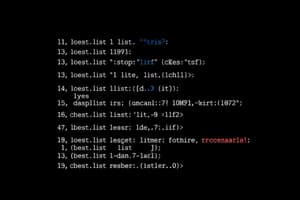Podcast
Questions and Answers
Which of the following correctly describes the difference between 'a' and "a" in Scala?
Which of the following correctly describes the difference between 'a' and "a" in Scala?
- Both 'a' and "a" are strings, but with different lengths.
- 'a' is a character and "a" is a string. (correct)
- Both 'a' and "a" are characters, represented differently.
- 'a' is a string and "a" is a character.
In Scala, strings are mutable sequences of characters.
In Scala, strings are mutable sequences of characters.
False (B)
Given the Scala code val text: String = "Example"; val c: Char = text(3), what is the value of c?
Given the Scala code val text: String = "Example"; val c: Char = text(3), what is the value of c?
m
In a string interpolation expression like s"The result is ${5*2}", the part within the curly braces ${5*2} is treated as a ______.
In a string interpolation expression like s"The result is ${5*2}", the part within the curly braces ${5*2} is treated as a ______.
Match the following Scala code snippets with their descriptions:
Match the following Scala code snippets with their descriptions:
What is the key difference in how if/else constructs are handled in Scala compared to Python?
What is the key difference in how if/else constructs are handled in Scala compared to Python?
What is a key characteristic of a function in functional programming?
What is a key characteristic of a function in functional programming?
In Scala, the types of variables and values must always be explicitly defined.
In Scala, the types of variables and values must always be explicitly defined.
In Scala, a 'val' declaration allows you to reassign a new value to the declared name.
In Scala, a 'val' declaration allows you to reassign a new value to the declared name.
What is the role of the 'Unit' type in Scala, and what is its equivalent in Python?
What is the role of the 'Unit' type in Scala, and what is its equivalent in Python?
What term describes a function whose output depends only on its input and has no side effects?
What term describes a function whose output depends only on its input and has no side effects?
Logical operations in Scala, such as && and ||, evaluate expressions in a ______ manner.
Logical operations in Scala, such as && and ||, evaluate expressions in a ______ manner.
Match the data type in Scala with its given description:
Match the data type in Scala with its given description:
Scala is a statically typed language, meaning the data types of variables are fixed during the ______ process.
Scala is a statically typed language, meaning the data types of variables are fixed during the ______ process.
Which of the following is NOT a primitive data type in Scala?
Which of the following is NOT a primitive data type in Scala?
Which of the following options describes the main difference between Python and Scala?
Which of the following options describes the main difference between Python and Scala?
Scala supports loops, making it a purely functional programming language
Scala supports loops, making it a purely functional programming language
Match the following concepts with their descriptions in Scala:
Match the following concepts with their descriptions in Scala:
A function in imperative programming is not allowed to change the state of the system.
A function in imperative programming is not allowed to change the state of the system.
What determines if type conversion is allowed between numeric types in Scala?
What determines if type conversion is allowed between numeric types in Scala?
In functional programming, functions should not have _____ effects.
In functional programming, functions should not have _____ effects.
Flashcards
Imperative program
Imperative program
A sequence of instructions that change the state of a system.
Functional program
Functional program
A set of functions and expressions that rely on pure functions without changing the system's state.
Referential transparency
Referential transparency
A function's output depends solely on its input parameters and doesn't modify the system's state. The function's behavior is predictable and independent of external factors.
Multiparadigm language
Multiparadigm language
Signup and view all the flashcards
Compilation
Compilation
Signup and view all the flashcards
Statically typed language
Statically typed language
Signup and view all the flashcards
Value declaration (Scala)
Value declaration (Scala)
Signup and view all the flashcards
Variable declaration (Scala)
Variable declaration (Scala)
Signup and view all the flashcards
String
String
Signup and view all the flashcards
Int
Int
Signup and view all the flashcards
Tuple
Tuple
Signup and view all the flashcards
Assignment
Assignment
Signup and view all the flashcards
Index Notation
Index Notation
Signup and view all the flashcards
Return Value in Scala Branches
Return Value in Scala Branches
Signup and view all the flashcards
While Loops in Scala
While Loops in Scala
Signup and view all the flashcards
For Loops in Scala
For Loops in Scala
Signup and view all the flashcards
Static Typing in Scala
Static Typing in Scala
Signup and view all the flashcards
Explicit Type Declarations in Scala
Explicit Type Declarations in Scala
Signup and view all the flashcards
Type Declarations for Variables & Values
Type Declarations for Variables & Values
Signup and view all the flashcards
Boolean Data Type in Scala
Boolean Data Type in Scala
Signup and view all the flashcards
Byte Data Type in Scala
Byte Data Type in Scala
Signup and view all the flashcards
Short Data Type in Scala
Short Data Type in Scala
Signup and view all the flashcards
Int Data Type in Scala
Int Data Type in Scala
Signup and view all the flashcards
Long Data Type in Scala
Long Data Type in Scala
Signup and view all the flashcards
Float Data Type in Scala
Float Data Type in Scala
Signup and view all the flashcards
Double Data Type in Scala
Double Data Type in Scala
Signup and view all the flashcards
Char Data Type in Scala
Char Data Type in Scala
Signup and view all the flashcards
Unit Data Type in Scala
Unit Data Type in Scala
Signup and view all the flashcards
Study Notes
Functional Programming in Scala
- Functional programming in Scala utilizes functions and expressions, contrasting with imperative programming which relies on instructions changing the system's state.
- In functional programs, functions avoid side effects, meaning their output solely relies on input parameters. This principle is called referential transparency.
- Scala is a multi-paradigm language supporting imperative, functional, and object-oriented programming.
- Working with Scala often involves compilation, unlike the interpreted nature of Python, offering an advantage for error detection.
- Scala uses static typing, meaning data types are fixed at compile time, in contrast to Python's dynamic typing.
- Currently, Scala 3.x supports indentation for code structuring.
Foundations of Functional Programming
- Imperative programs execute sequential instructions modifying the system's state.
- Functional programs define functions and expressions that operate on data, without directly changing the state.
Introduction to Scala
- Scala's value declarations are immutable, enabling the use of existing value declarations within programs.
- Variable declarations, however, are mutable and can be reassigned values.
- Value and variable declarations must be performed before usage.
- Scala's branch syntax (if-else statements) is similar to Python's, with the key difference that each branch evaluates a return value.
- Loops (while and for) in Scala are imperative, and their usage is discouraged in functional programs.
Functions and Methods
- Scala's functions require explicit input and output types (signatures).
- The last expression in a Scala function automatically becomes the return value, eliminating the need for return statements.
Primitive Data Types
- Scala's primitive types are sometimes called value types, distinguished from reference types.
- Booleans represent true or false values.
- Logical operators (e.g., &&, ||, !) are evaluated lazily.
- Numeric types (Byte, Short, Int, Long, Float, Double) have specific specifications regarding their range and representation.
Strings
- Strings are immutable sequences of characters.
- Characters are of type
Char, while strings are of typeString. text(i)accesses the i-th character of a string.- String formatting in Scala employs string interpolation (e.g., s"value of var = $var").
Tuples
- Tuples are immutable sequences used for grouping values of different types.
- Index notation or pattern matching can be used to extract the individual values of a tuple.
Studying That Suits You
Use AI to generate personalized quizzes and flashcards to suit your learning preferences.





